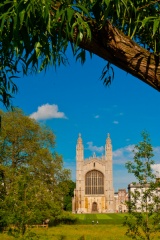British Gothic Architecture
 Salisbury Cathedral
Salisbury Cathedral
Like any classification system in the arts these styles cannot be dogmatically assigned dates, but for the sake of simplicity let's do it anyway.
The term "Gothic" itself needs some explaining. The original style of building - one might call it a philosophy of architecture - sprang up in the Ile de France, and was known during the Middle Ages as "the French Style".
Gothic Time Periods
- Norman Gothic 1066-1200
- Early English Gothic 1200-1275
- Decorated Gothic 1275-1375
- Perpendicular Gothic 1375 - 1530+
Wells Cathedral Chapter House
It was not until the 16th century that art critic Giorgio Vassari derisively compared medieval architecture to the barbarism (and presumed lack of taste) of the Goths who had ravaged Rome. It was only then that the term "Gothic" came into vogue. So what were the characteristics of a Gothic building? Generally speaking, Gothic architecture emphasized strong vertical lines, high vaulted ceilings, minimal wall space, pointed window and door openings, and buttressed walls. But these characteristic Gothic themes did not spring into being overnight. Let's see how the style of Gothic architecture evolved in Britain.
So what were the characteristics of a Gothic building? Generally speaking, Gothic architecture emphasized strong vertical lines, high vaulted ceilings, minimal wall space, pointed window and door openings, and buttressed walls. But these characteristic Gothic themes did not spring into being overnight. Let's see how the style of Gothic architecture evolved in Britain.
The Norman Gothic period (1066-1200) wasn't a whole lot different from Gothic elsewhere in Europe. The British temperament had yet to stamp its own mark on the new "French style".
The buildings of this time are transitional - many still have the thick piers and rounded window openings of the earlier Romanesque style. Vaulting and decoration are simple; there is little sign of the elaborate stonework to come. Some good examples of the Norman Gothic period are: Durham Cathedral, Wells Cathedral, and Ely Cathedral (west tower 1150-75).
It is in the Early English period (1200-1275) that the Gothic style became truly adapted by English craftsmen/architects. This period is also called "Lancet", referring to the pointed lancet windows (narrow, untraceried) that characterize it. Form is still austere and proportion is magnificently simple.
 The main points of Early English are: quadripartite ribbing in vaults, slender towers topped with spires, lancet windows - both single and grouped - and piers with narrow, clustered shafts. The finest example of Early English is to be found at Salisbury Cathedral.
The main points of Early English are: quadripartite ribbing in vaults, slender towers topped with spires, lancet windows - both single and grouped - and piers with narrow, clustered shafts. The finest example of Early English is to be found at Salisbury Cathedral.
Bath Abbey vaulting
Decorated Gothic (1275-1375) - aka Geometric, Curvilinear, and Flamboyant - These terms describe primarily the fanciful tracery and ornamentation found in the window heads during this time. Windows were wider than the earlier lancet openings (see above).This widening and the lessening in wall area that naturally accompanied it was made possible by the invention of the flying buttress. Improved vaulting techniques also helped take the strain of supporting the building's weight off the walls, which could then become little more than shells with broad window openings. Stone decoration was rich and varied, and window glass more colorful. Stone carvings and paintings abound. The best example of the Decorated period you can visit today is at Exeter Cathedral.
The final flourishing of Gothic in Britain was the Perpendicular period (1375-1530+). The name suggests its chief characteristic - strong vertical lines in window tracery and wall paneling. Vaults were elaborate fan shapes, and the flying buttress became a flowing, decorative feature (as well as supplying its essential supporting strength).
King's College Chapel,
Cambridge
All of the examples cited in this article are cathedrals. This is because it was generally only in the great churches that the architects of the time were given creative license. But there are also less exalted examples to be found.
Most parish churches in Britain date from the Medieval Gothic period, and it can be a fascinating exercise to trace the changes in style as the church was remodelled over time. You can often find simple Early English elements cheek-by-jowl with Decorated and Perpendicular additions.






